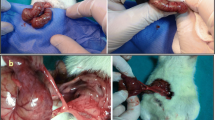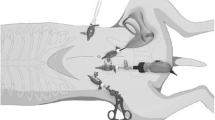Abstract
Intraoperative irrigation of the peritoneal cavity with scolicidal agents is frequently recommended when dealing with traumatic or spontaneous rupture of hydatid cysts. The present experimental study was designed to examine the influence of various scolicidal agents on adhesion formation and survival. A total of 149 rats were randomly allocated to nine groups. Peritoneal lavage through a median laparotomy was performed with the following scolicidal agents. Group 1 (0.9% saline: controls), group 2 (20% hypertonic saline), group 3 (0.04% chlorhexidine gluconate), group 4 (3% hydrogen peroxide), group 5 (0.5% silver nitrate), group 6 (1% polyvinylpyrrolidone-iodine, or PVP-I ), group 7 (5% PVP-I), group 8 (0.5% cetrimide/0.05% chlorhexidine), and group 9 (10% PVP-I). The surviving animals were sacrificed on postoperative day 15. Adhesion formation was macroscopically graded by the Nair criteria. The severity of adhesion formation was evaluated microscopically using the fibrosing scoring criteria and the strain test. Group 9 (10% PVP-I) was excluded from the adhesion evaluation because all of the rats died in this group. The mortality rate was significantly higher in groups 5 and 7 than in groups 1, 2, 3, 4, 6, and 8. Adhesion scores were significantly lower in groups 1, 2, 3, and 4 than in groups 5, 6, 7, and 8. The lowest adhesion score was found in group 3 and the highest in the group 7. These results indicate that 0.04% chlorhexidine gluconate, the most potent scolicidal agent in vitro and in vivo, was associated with the lowest adhesion formation and mortality among various scolicidal agents in this experimental study.
Similar content being viewed by others
References
Ellis H, Moran BJ, Thampson JN, et al. Adhesion related hospital readmissions after abdominal and pelvic surgery: a retrospective cohort study. Lancet 1999;353:1476–1480
De Cherney AH, Dizerega GS. Clinical problem of peritoneal adhesion formation following general surgery and use of adhesion prevention barriers. Clin North Am 1997;77:671–688
diZerega GS. Use of adhesion prevention barriers in ovarian surgery, tubalplasty, ectopic pregnancy, endometriosis, adhesiolysis, and myomectomy. Curr Opin Obstet Gynecol 1996;8:230–237
Ray NF, William G, Denton RN, et al. Abdominal adhesiolysis: inpatient care and expenditures in the United States in 1994. J Am Coll Surg 1998;186:1–9
Taylor DH, Morris DL. The current management of hydatid disease. Br J Clin Pract 1988;42:401–406
Langer B. Surgical treatment of hydatid disease of the liver. Br J Surg 1987;74:237–242
Mottaghian H, Saidi F. Postoperative recurrences of hydatid disease. Br J Surg 1978;65:237–242
Cakmakci M, Sayek I. Prophylactic effect of albendazole in experimental peritoneal hydatidosis. Hepatogastroenterology 1992;39:424–426
Nair SK, Bhat KI, Aurora LA. Role of proteolytic enzyme in the prevention of postoperative intraperitoneal adhesions. Arch Surg 1974;108:849–853
Erenoglu C, Akın ML, Aydın S, et al. The prophylactic effect of interferon and vitamin E on postoperative peritoneal adhesions (experimental study). Cagdas J Surg 1997;11:195–198
Menzies D, Ellis H. Intestinal obstruction from adhesions: how big is the problem? Ann R Coll Surg Engl. 1990;72:60-63
Ray NF, Larsen JW, Stillman RU, et al. Economic impact of hospitalization for lower abdominal adhesiolysis in the United States in 1988. Surg Gynecol Obstet 1993;176:271
Amir-Jahed AK, Fardin R, Farzad A, et al. Clinical echinococcosis. Ann Surg 1975;182:541–546
Little JM, Holland MJ, Ekberg H. Recurrence of hydatid disease. World J Surg 1988;65:700–704
Barros JL. Hydatid disease of the liver. Am J Surg 1978;135:597–600
Gokce O, Gokce C, Yilmaz M, et al. Povidone-iodine in experimental peritoneal hydatidosis. Br J Surg 1991;78:495–496
Landa Garcia JI, Alonso E, Gonzalez-Uriarte J, et al. Evaluation of scolicidal agents in an experimental hydatid disease model. Eur Surg Res 1997;29:202–208
Puryan K, Karadayi K, Topcu O, et al. Chlorhexidine gluconate: an ideal scolicidal agent in the treatment of intraperitoneal hydatidosis? World J Surg 2005;29:227–230
Besim H, Karayalcin K, Hamamci O, et al. Scolicidal agents in hydatid cyst surgery. HPB Surg 1998;10:347–355
LeVeen HH, LeVeen FR, LeVeen EG. The mythology of povidone-iodine and the development of self-sterilizing plastics. Surg Gynecol Obstet 1993;176:183–189
Mazuji MK, Fadhli HA. Peritoneal adhesions. Arch Surg 1965;19:872–874
Badowski A, Daciews Z. The importance of high molecular weight colloid substances in prevention of peritoneal adhesions. Polish Med J 1971;10:147–153
Janik JS, Nagaraj HS, Groff DB. Prevention of postoperative peritoneal adhesions: efficacy of povidone. Arch Surg 1982;117:1321–1324
Gilmore OJ, Reid C. Prevention of intraperitoneal adhesions: a comparison of noxythiolin and a new povidone-iodine/PVP solution. Br J Surg 1979;66:197–199
Van Westreenen M, van den Tol PM, Pronk A, et al. Perioperative lavage promotes intraperitoneal adhesion in the rat. Eur Surg Res 1999;31:196–201
Roberts LM, Sanfilippo JS, Raab S. Effects of laparoscopic lavage on adhesion formation and peritoneum in an animal model of pelvic inflammatory disease. J Am Assoc Gynecol Laparosc 2002;9:503–507
Mund-Hoym S, Roberg A. Adhesion prophylaxis-a comparative experimental animal study. Res Exp Med 1982;181:171–180
Meymerian E, Luttermoser GW, Frayha GJ, et al. Host-parasite relationships in echinococcosis. X. Laboratory evaluation of chemıcal scolicides as adjuncts to hydatid surgery. Ann Surg 1963;2:211–215
WHO Informal Working Group on Echinococcosis. Bull WHO 1996;74:231–242
Magistrelli P, Masetti R, Coppola R, et al. Surgical treatment of hydatid disease of the liver: a 20-year experience. Arch Surg 1991;126:518–523
Djilali G, Mahrour A, Oussedik T, et al. Hydrogen peroxide in the surgery of hydatid cyst. Presse Med 1983;12:235–237
Belghiti J, Perniceni T, Kabbej M, et al. Complications of peroperative sterilization of hydatid cysts of the liver: apropos of 6 cases. Chirurgie 1991;117:343–346
Kayaalp C, Balkan M, Aydin C, et al. Hypertonic saline in hydatid disease. World J Surg 2001;25:975–979
Sonisik M, Korkmaz A, Besim H, et al. Efficacy of cetrimide-chlorhexidine combination in surgery for hydatid cyst. Br J Surg 1998;85:1277
Baraka A, Wakid N, Yamout F. Methemoglobinemia during surgical excision of hydatid cyst. Middle East J Anaesthesiol 1980;5:509–513
Momblano P, Pradere B, Jarrige N, et al. Metabolic acidosis induced by cetrimonium bromide. Lancet 1984;2:1045
Gilchrist DS. Chemical peritonitis after cetrimide washout in hydatid-cyst surgery. Lancet 1979;2:1374
Karayalcin K, Besim H, Koyuncu A, et al. Effect of peritoneal lavage with cetrimide-chlorhexidine solution on survival and adhesion formation in rat: an experimental study. T Clin J Med Res 1998;16:26–28
Laufhman H. Current use of skin and wound cleansers and antiseptics. Am J Surg 1989;157:359–365
Platt J, Jones RA, Bucknall RA. Intraperitoneal antiseptics in experimental bacterial peritonitis. Br J Surg 1984;71:626–628
Celdran Uriarte A, Inarrea Lasheras P, Marijuan Martin JL, et al. Effect of povidone iodine and chlorhexidine on the mortality and bacterial clearance in the abdominal cavity of peritonitis rats. Eur J Surg 1991;157:393–395
Vallance S, Waldron R. Antiseptic vs saline lavage in purulent and faecal peritonitis. J Hosp Infect 1985;6:87–91
Bondar VM, Rago C, Cottone FJ, et al. Chlorhexidine lavage in the treatment of experimental intra-abdominal infection. Arch Surg 2000;135:309–314
Maleckas A, Daubaras V, Vaitkus V, et al. Increased postoperative peritoneal adhesion formation after the treatment of experimental peritonitis with chlorhexidine, Langenbecks Arch Surg 2004;389:256–260
Author information
Authors and Affiliations
Corresponding author
Rights and permissions
About this article
Cite this article
Topcu, O., Kuzu, I. & Karayalcin, K. Effects of Peritoneal Lavage with Scolicidal Agents on Survival and Adhesion Formation in Rats. World J. Surg. 30, 127–133 (2006). https://doi.org/10.1007/s00268-005-7960-4
Published:
Issue Date:
DOI: https://doi.org/10.1007/s00268-005-7960-4




